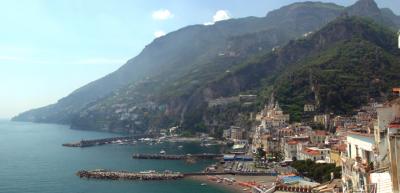
Amalfi from hotel patio. Caters to tourists during the day, but we could always feel the presence of its indigenous elements. |
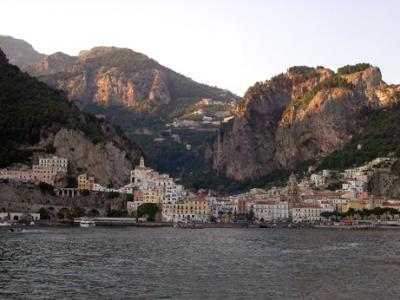
Amalfi as seen from a boat. Ravello also is seen here above Amalfi. |

Piazza Flavio Gioia as seen from the patio of our room at the Hotel Luna Convento. The camera's lens was set to telephoto. |
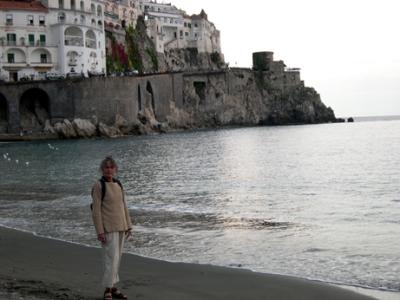
Judy on the beach. The Hotel Luna Convento where we stayed, is the white-beige building at the top of the hill (background). |
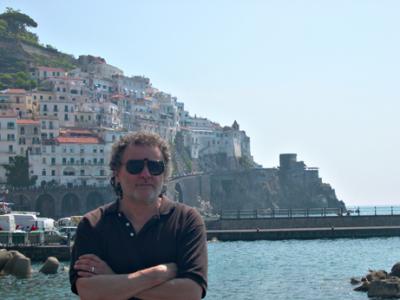
Richard on a pier in Amalfi. Our hotel and guard tower are seen at the top of the hill. |

The hotel (Luna Convento) where we stayed is at the top of this hill opposite the round tower. |
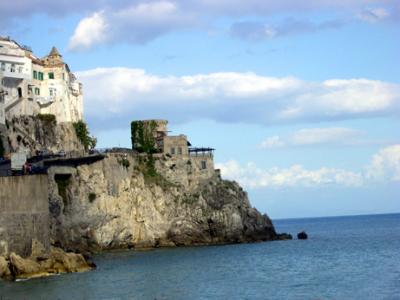
The Hotel Luna Convento & guard tower (now a hotel suite and a restuarant) as seen from the beach. Used a telephoto setting. |
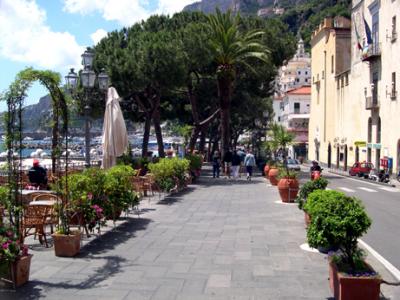
Looking toward Amalfi while walking up the hill to our hotel (Luna Convento) |
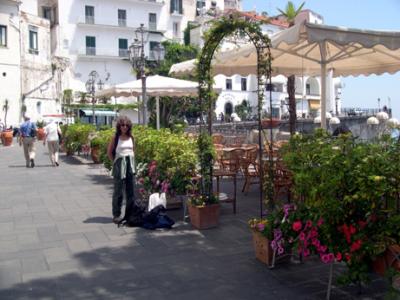
Judy on the hill to our hotel. She is facing toward Amalfi. |
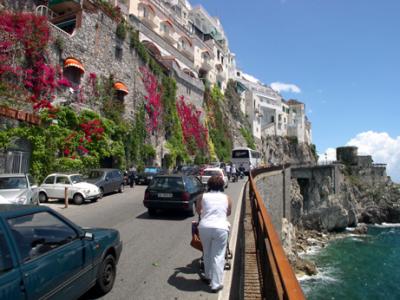
Walking up the hill to our hotel - narrow road, lots of traffic & no sidewalk - woman pushing a baby stroller. |
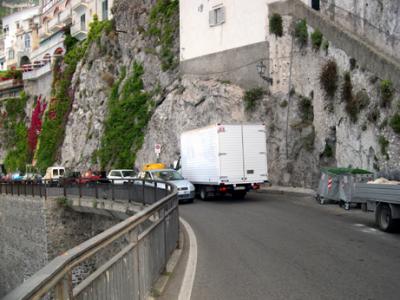
Tight squeeze for the drivers on the road to our hotel - typical of the roads on the Amalfi Coast. |
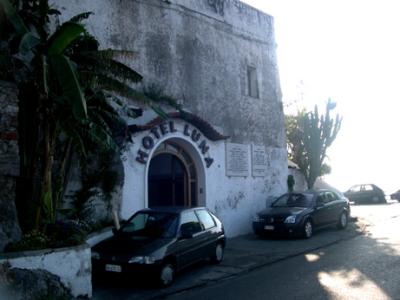
Entrance to the Hotel Luna Convento - top of the hill. Hotel was a 13th cent. convent but redone to suit its present purpose. |
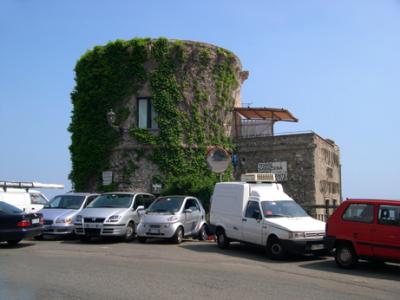
Torre San Francesco, across from hotel entrance, overlooking Tyrrhenean Sea. Mirror is for cars to see around the bend. |
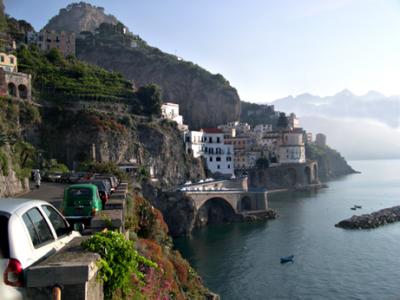
Atrani - looking east from the front of the Hotel Luna Convento. |
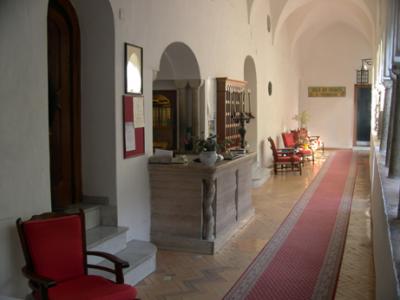
The front desk of the Hotel Luna Convento. The original (13th century) open air cloister is to the right. |
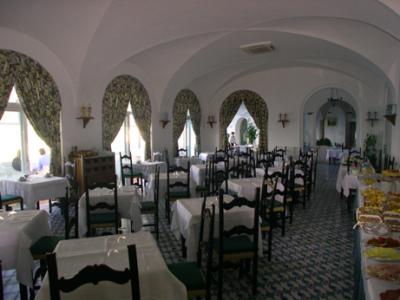
The dining room and breakfast area (including outdoor patio) of the Hotel Luna Convento. |
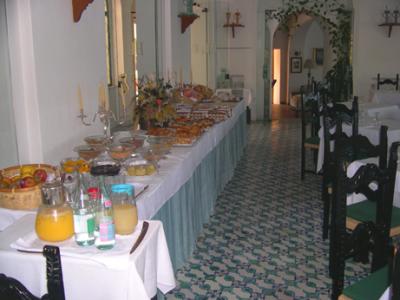
Breakfast buffet at the Hotel Luna Convento. Big breakfast kept us going each day, but we didn't skip gelato. |
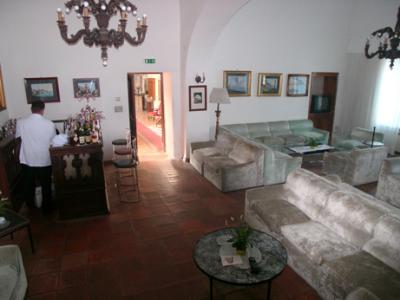
The bar at the Hotel Luna Convento |
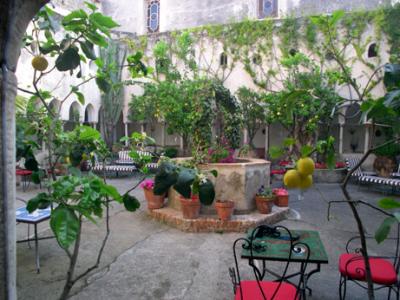
The original 13th century hotel cloister, supposedly founded by St. Francis of Assisi. Now a place to have a glass of wine. |
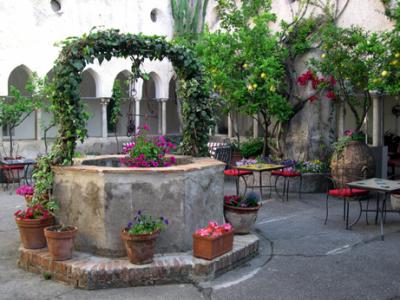
Cloister & lemon trees. Lemons from area less sour than others - eaten like other fruit (but with salt to neutralize acidity). |
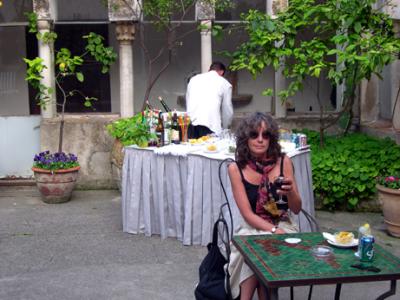
Judy having a glass of wine in the 13th century hotel cloister. |
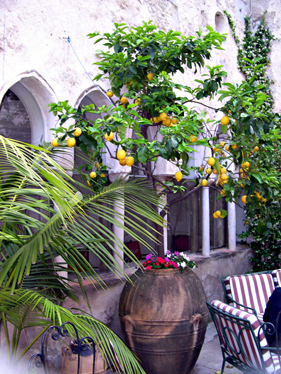
Lemon tree in cloister. Lemons grown on coast are more scented & less sour than lemons grown elsewhere - great for limoncello. |
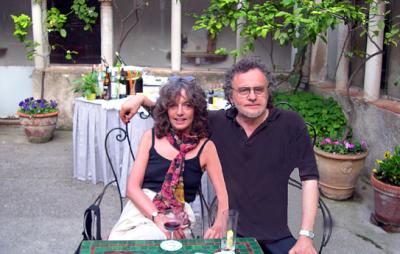
Judy and Richard in the hotel cloister |
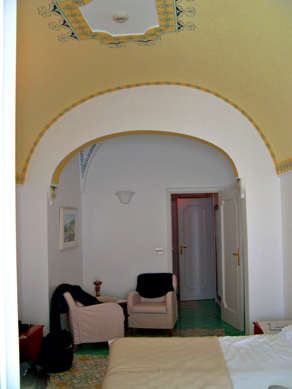
Our hotel room, facing the entrance |
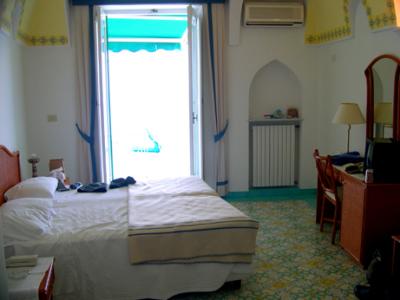
Our hotel room facing the patio. |
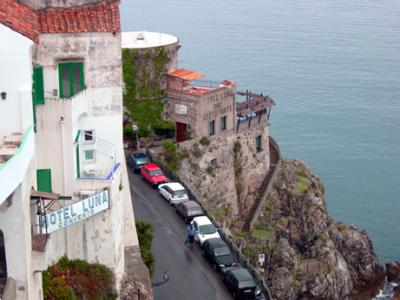
Tower (and restaurant) from patio with telephoto setting. Fortification at least 500 years old - could even be from 13th cent. |
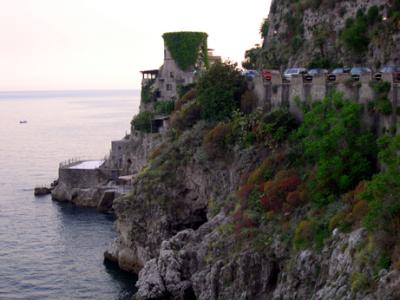
Tower and pool - looking west as seen from Atrani. |
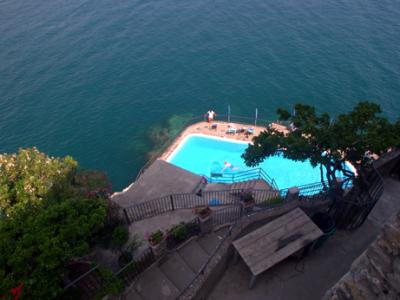
The hotel pool as seen from the road, next to the tower. |
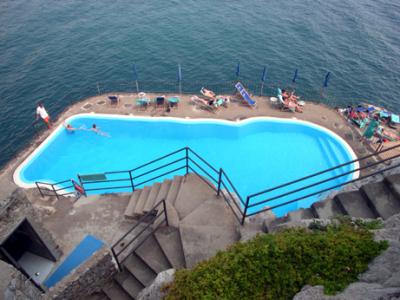
The hotel pool as seen from the road, next to the tower. A telephoto setting was used. |
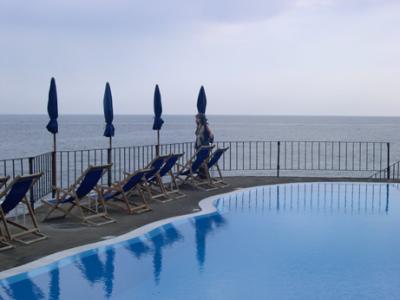
Judy at the pool. |
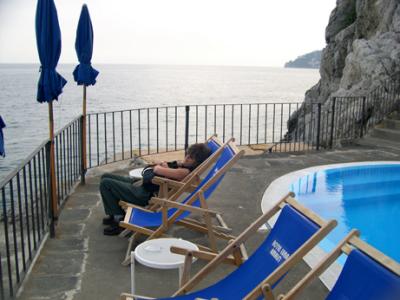
Judy relaxing - hotel pool. Our luggage was delayed for two days (mishap at the Paris airport), so she is not fully prepared. |
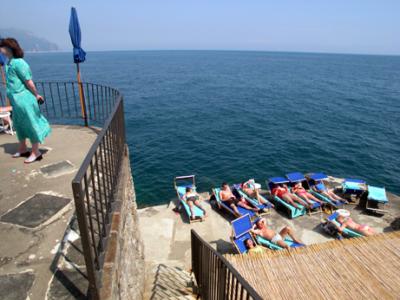
Judy near the hotel pool. She was on her stomach on the left beach chair. The pool is the raised area to the left. |
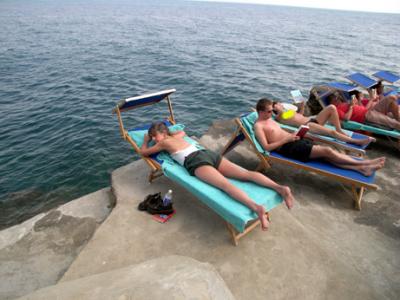
Judy near hotel pool. Another woman was topless (covered in yellow by me). I didn't notice until Judy told me - bad sign :-) |
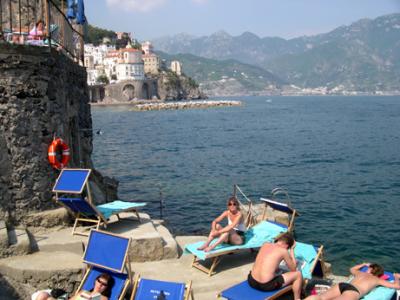
Judy near hotel pool, which is the raised area on the left. Topless woman was lying on her stomach. Atrani is in the background. |
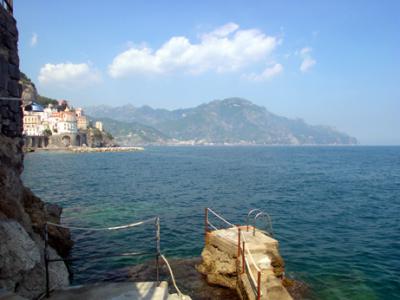
We wanted to go for a swim in the Tyrrhenean Sea from this platform near the pool, but the water was too cold. |
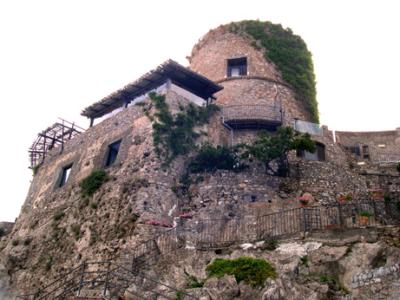
Tower and restaurant near hotel as seen from pool area. Tower at least 500 years old. Protected against pirates & invaders. |
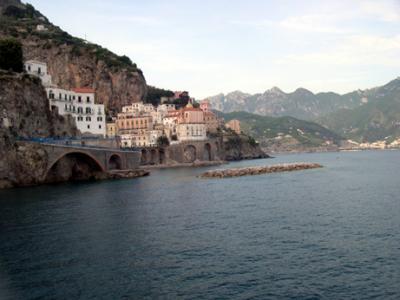
Looking east from the pool area toward Atrani. |
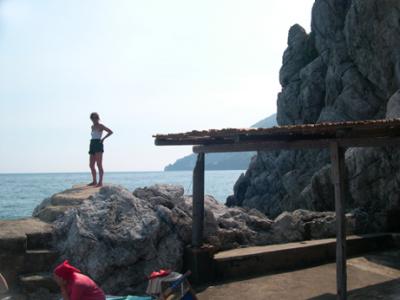
Judy exploring near the pool area. View is toward the west. |
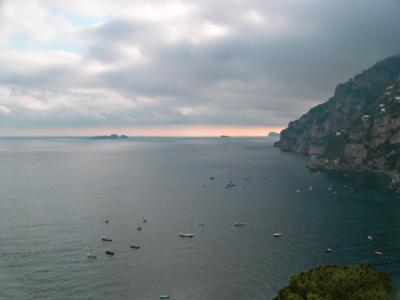
View from pool area looking west at sunset. |
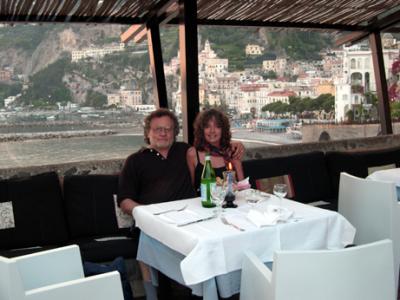
Judy and Richard having dinner at the restaurant in the guard tower. Amalfi is in the background. |
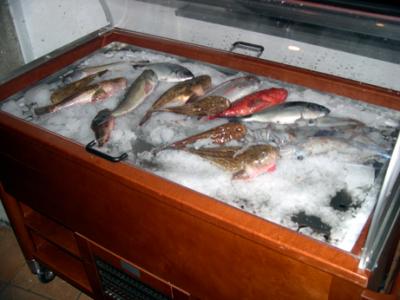
We chose fish (the red Scorfano) from the daily catch for our dinner at the tower restaurant. |
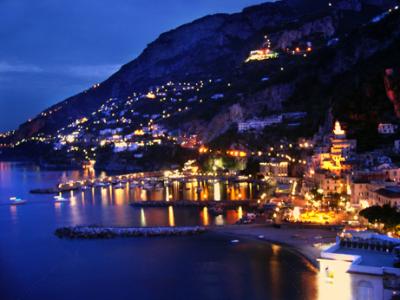
Amalfi in early evening light. Photo from the patio of our hotel room - telephoto setting. |
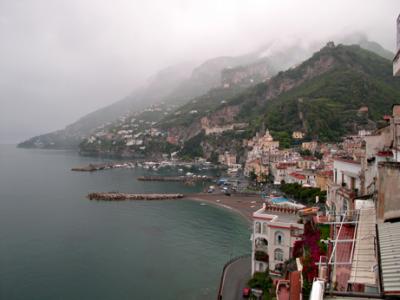
Amalfi in the morning from the patio of our hotel room. |
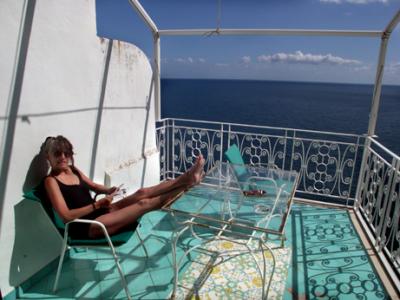
Judy on the patio of our hotel room, catching a few rays. |
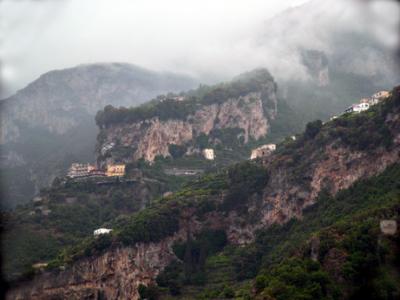
Cliffs and mountains in Amalfi. Photo taken from the patio of our hotel room. |
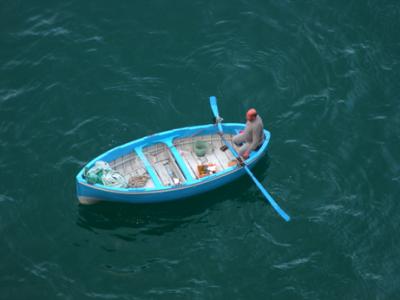
An early morning fisherman as seen from the patio of our hotel room. |
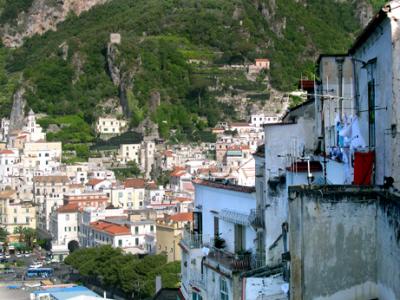
Amalfi: Laundry hanging outside the adjacent house - common site in Italy. Photo from our patio. |
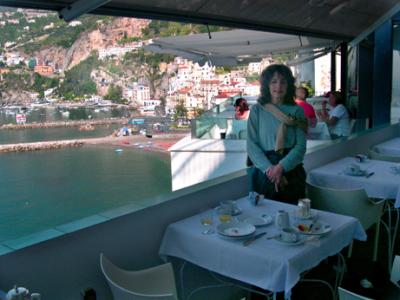
Judy after breakfast at the Hotel Luna Convento. Amalfi is in the background. |
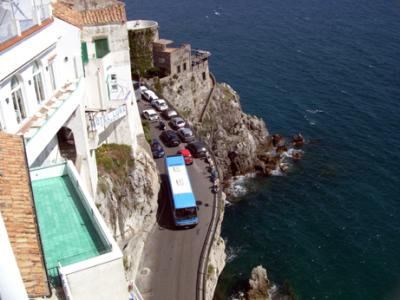
Traffic on narrow rode in front of hotel - requires skillful drivers. Outdoor hotel breakfast area on left. From our patio. |

Cars, scooters, pedestrians and a bus on the road in front of our hotel. Seen from our patio. Always fun to watch. |
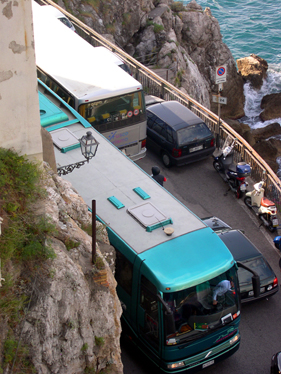
Typical traffic on the Amalfi Coast. A few inches often separate buses. Telephoto setting from our patio. |
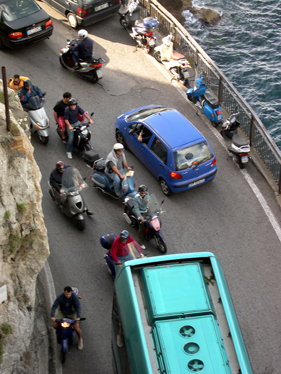
Road in front of our hotel. Traffic often chaotic on the Amalfi Coast. Telephoto setting from patio. |
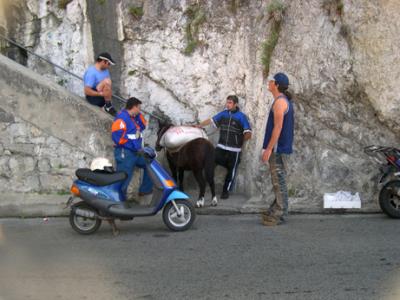
Burro with supplies for the hotel. Burro proceeded up the steps to deliver them. |

Steps used by burro (previous photo). Other supplies delivered via pulley shown here. Doors & elevators too small for supplies. |
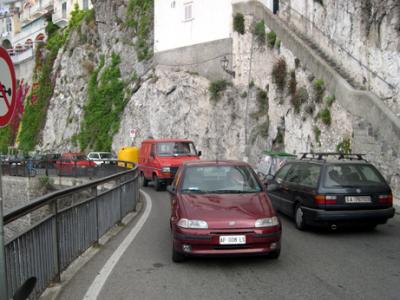
More heavy traffic near hotel. No sidewalks. Pedestrians a few feet or inches from oncoming cars, as I was taking this photo. |
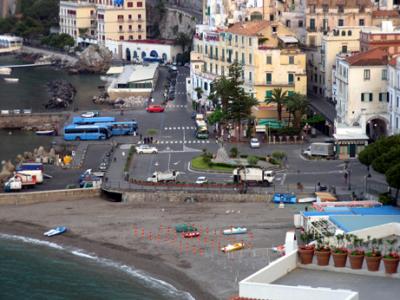
Piazza Flavio Gioia and the beach in Amalfi as seen from our patio. Telephoto setting. |
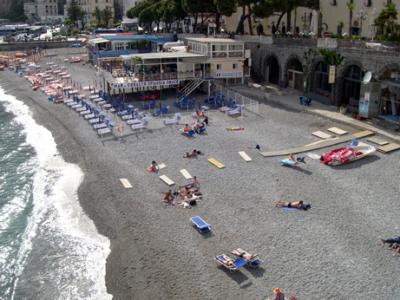
The beach in Amalfi. Small stones cover the beach. Beach chairs are a requirement for the uninitiated. |
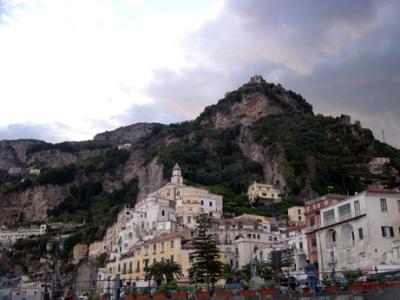
Amalfi and a structure on the mountaintop, as seen from the beach. People somehow built that structure on the mountaintop. |
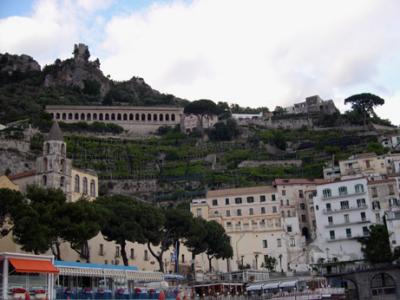
From the beach: Arched structure is cemetery. Above it, Ziro's Tower (at least 500 years old). Umbrella Pine is to the right. |
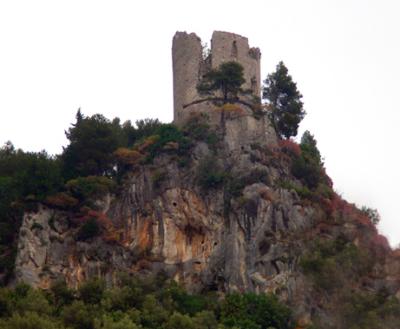
Ziro's Tower high above Amalfi. At least 500 years old. (13th cent?) Protection against pirates & invaders. Telephoto setting. |
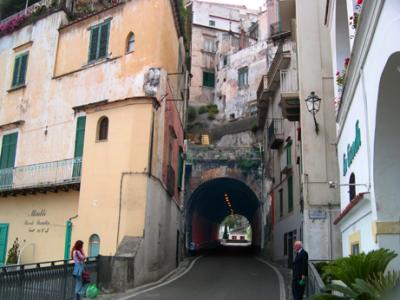
Street near Piazza Flavio Gioia. We ate at La Caravella Restaurant on the right side of the photo. It is partially seen here. |
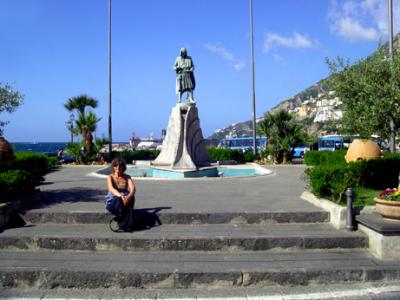
Judy near Flavio Gioia statue - legendary Amalfi sailor supposedly invented compass (15th cent. legend). Piazza named after him. |
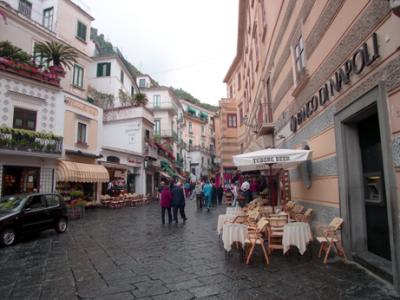
Main street off the Piazza Duomo. Local residents need pass to get cars into this area. See next photo for blowup. |
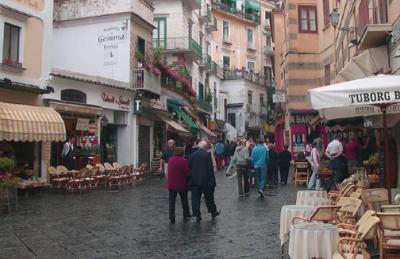
Low balcony (left): Da Gemma - we ate there. Traffic light (right) - one way traffic - 10 minute wait. Crop from previous photo. |
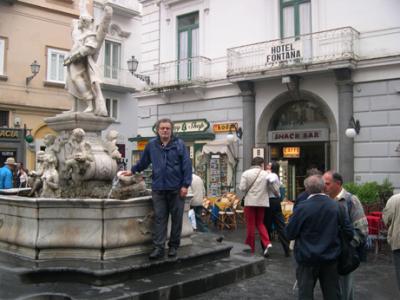
Richard at Fountain of St. Andrew (1760) on Piazza Duomo. St. Andrew: fishermen saint and joint patron saint of the Amalfi Coast |
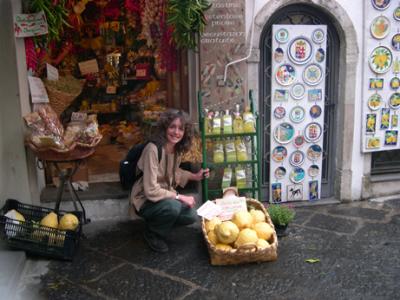
Judy at store. Giant lemons selling for 16 euros. Lemons grown on terraces on cliffs all along Amalfi Coast since the 15th c. |
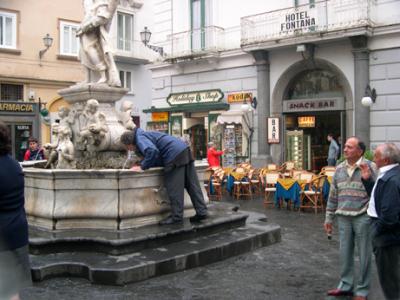
Richard drinking at St. Andrew's Fountain. Water from woman's breast - not sexual - everyone belongs to the church. |
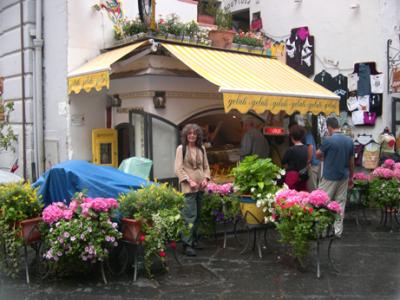
Judy in front of her favorite gelato store, Gelateria Porto Salvo. Trust her judgment; she is an expert :--) |
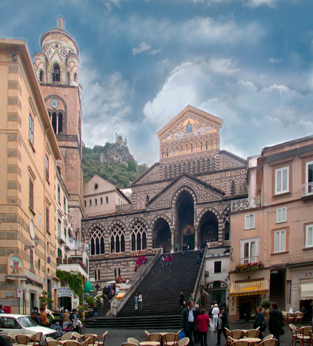
Duomo from 10th century but later altered - named in honor of St. Andrew. Bell tower (campanile) from 12th & 13th centuries. |
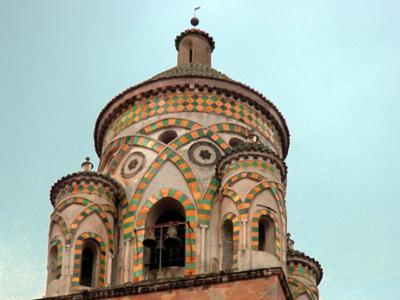
Top of bell tower - from the 12th and 13th centuries. Has Moorish features. |
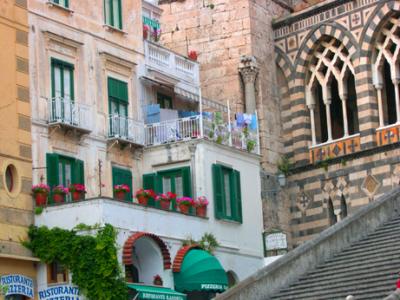
Hung laundry & potted flowers near Duomo. Laundry & potted flowers are so common in Italy as to seem somewhat symbolic. |
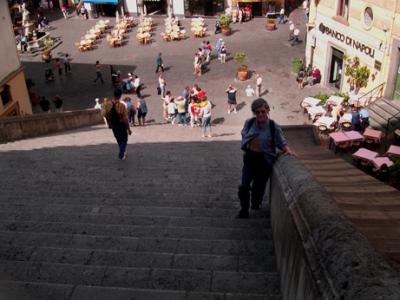
Judy on the steps of the Duomo with the Piazza Duomo in the background. Steps were modified in the 13th century. |
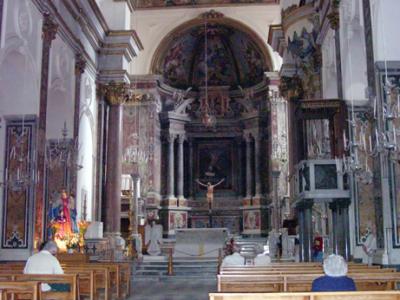
The nave and high alter of the Duomo. Baroque style. Wooden crucifix from the 13th cent. and paintings from the 18th cent. |
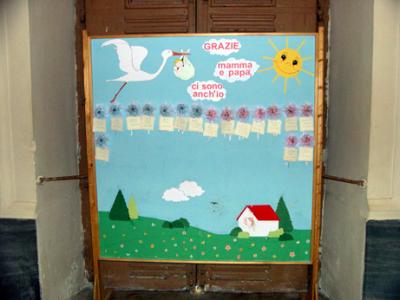
This list of newborn babies is at the back of the Duomo. The love of children permeates Italy. |
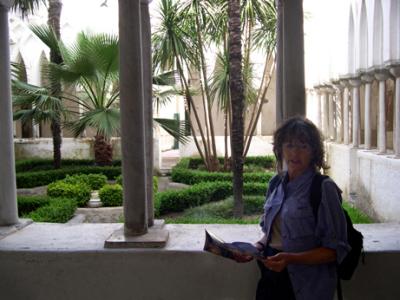
Judy in, "The Cloister of Paradise," (13th c.). Cloister attached to Duomo. Moorish style. Was a necropolis for aristocracy. |
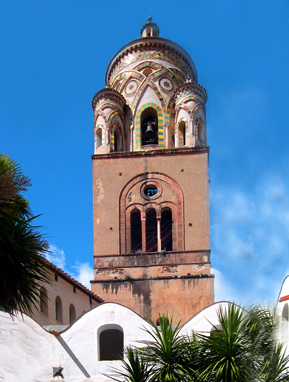
Bell tower (12th&13th centuries) seen from, "The Cloister of Paradise." Lower part Romanesque. Upper part Moorish. |
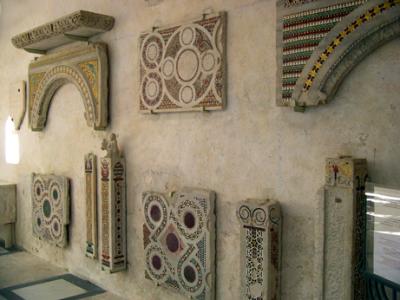
In "Cloister of Paradise." Roman & medieval archeological remains. Top left, arched piece is a medieval mosaic from the Duomo. |
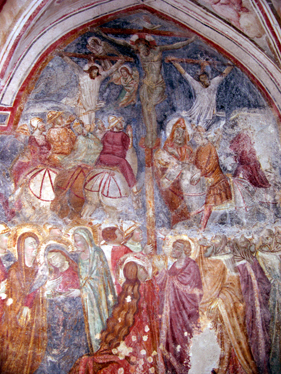
"The Crucifixion," (14th c.): Fresco by Roberto d'Oderisio in the small, "Chapel of Crucifixion." (13th & 14th cent. ) |
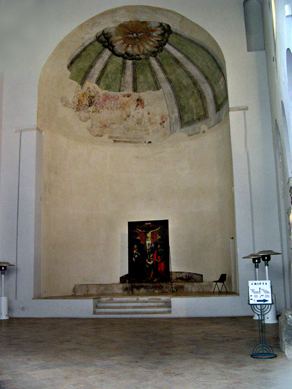
"Basilica of the Crucifix." Original church from the 9th century - now a museum. Attached to the Duomo. |
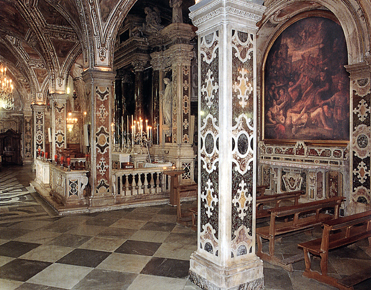
St. Andrew's Crypt (13th c.): His remains brought here during Crusades (1206) because of Amalfi's importance & wealth then. |
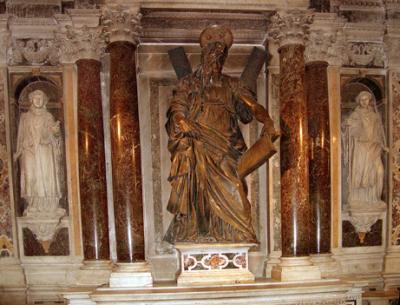
St. Andrew: Bronze statue (16th c.). St. Andrew's remains here include back of his head. Pope moved face to Greece. |
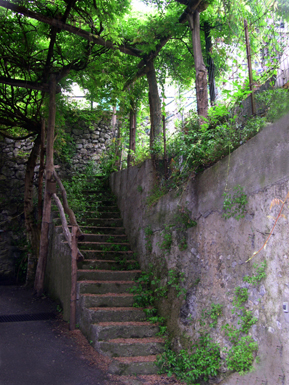
Steps to a street |

Steps to a passageway |
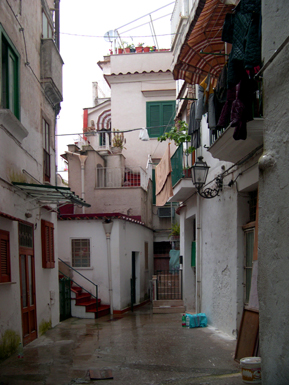
A passageway |

A red apartment with a wooden model of Amalfi. Model is historical showing Amalfi as it used to be. |
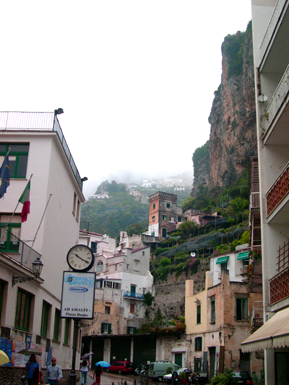
A street and surrounding mountains |
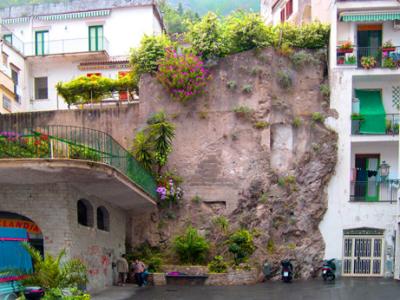
Street scene: The boys are pitching coins against the wall. |
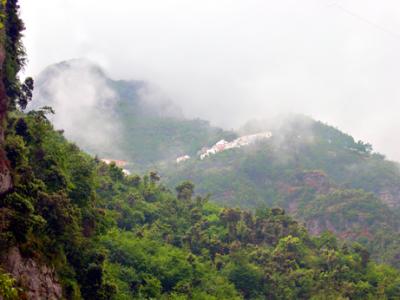
Surrounding mountains as seen from a street |
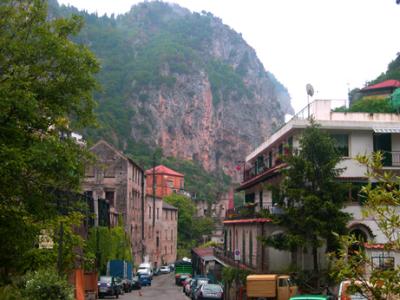
A street and surrounding mountains |
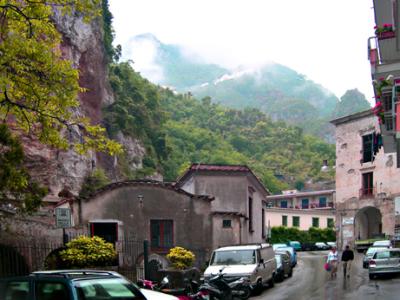
The lower structure on the left is the Paper Museum (Museo della Carta), in a 14th century paper mill. |
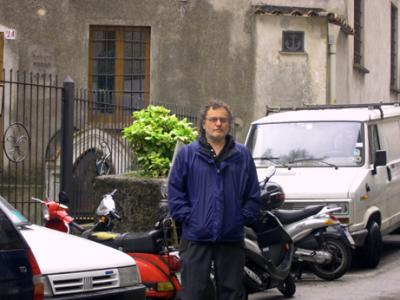
Richard in front of the Paper Museum (The building was a 14th century paper mill.) |
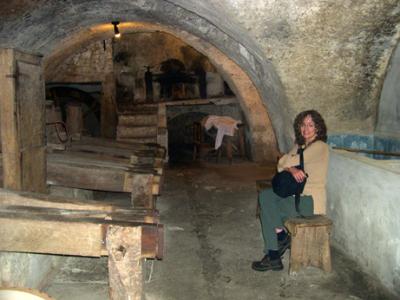
Judy inside the Paper Museum. People in Amalfi learned how to make cotton paper from the Arabs in the 12th century. |
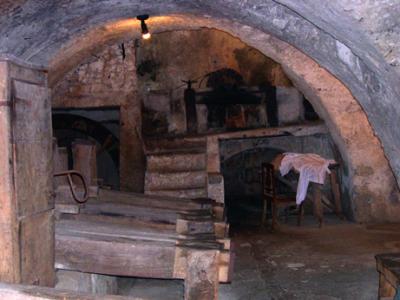
First, cotton rags were pulverized by wooden mallets - split the fibers - 14th century wooden machines (left). |
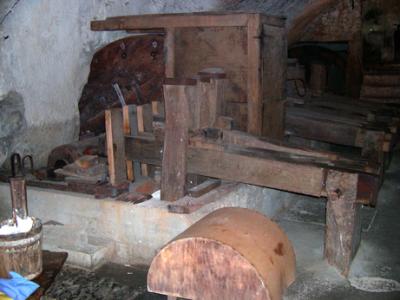
14th cent. machines to pulverize rags. Driven by power (small waterfall) from Canneto River, using a water wheel seen here. |
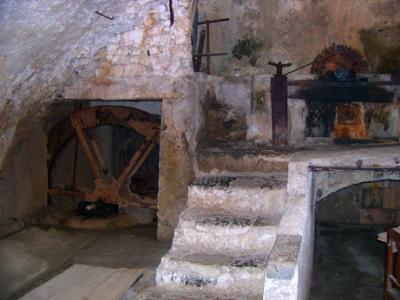
By 17 c., had metal machines: Cotton rags pulverized in tub (above steps) by metal wheel powered by water wheel. |
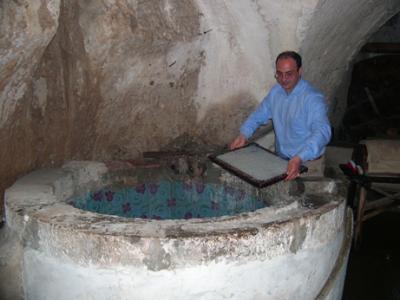
Pulverized cotton rags then put in vat of water. Cotton amalgamated with water and collected on a filter as seen here. |
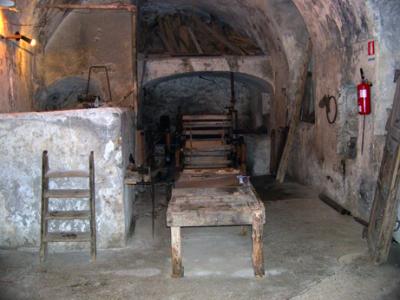
Then cotton paper was produced & collected on the drum (background) of this machine. Powered by a water wheel (left side). |
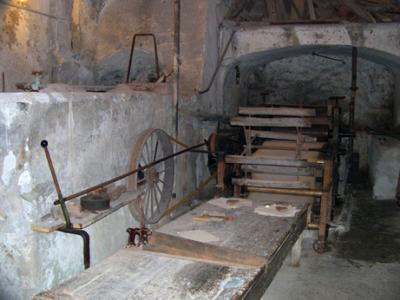
Closer look at the machine to produce roll of paper: The paper was then cut to size by the saw-like tool in the foreground. |
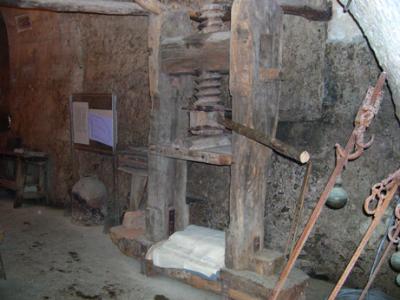
Press (18 c.) used to eliminate water residue from sheets of paper. (Watermarks often on sheets - from filter used earlier.) |
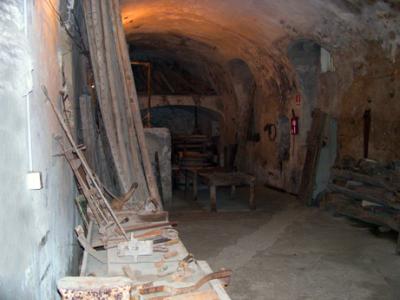
Paper dried outdoors on branches (shown here) but not in sun which turned paper yellow. Whole process today is similar. |
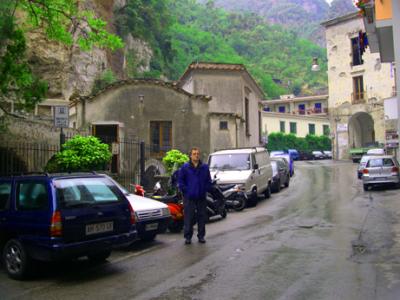
Richard in front of Paper Museum. Small waterfall (not shown) is behind the fence & powered paper making machines. |
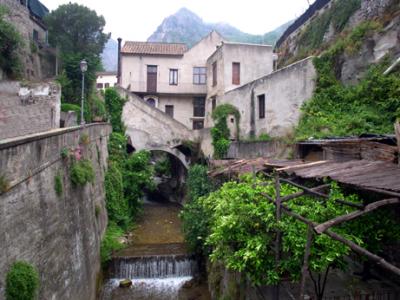
House and waterfall |
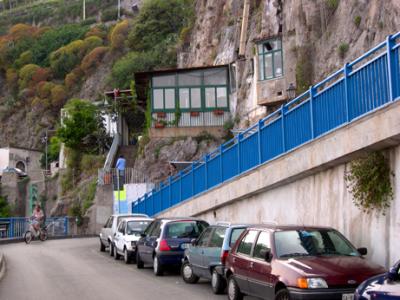
Up the steps is the entrance to Zaccaria Restaurant where we had dinner - between Amalfi & Atrani |
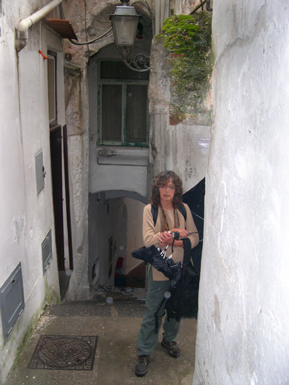
Judy in a passageway |
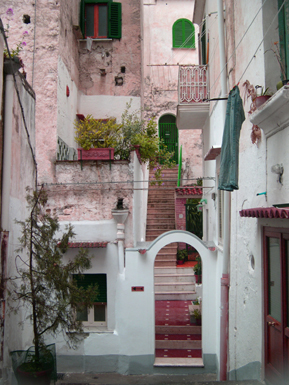
Houses |
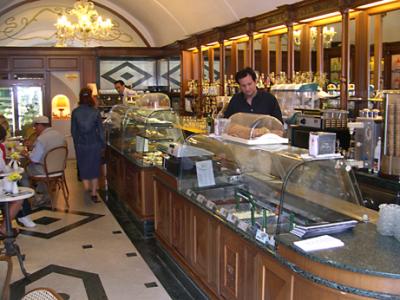
We often sat outside this snack food place on the Piazza Duomo to people-watch. |
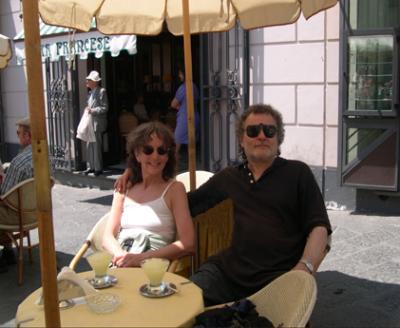
Judy and Richard having lemon granitas and doing some people-watching on the Piazza Duomo. Rare for Judy not to have espresso. |
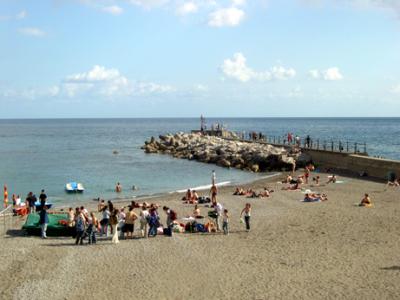
Teenagers at the beach after school. |
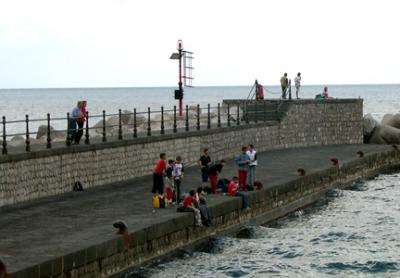
Teenagers fishing on the pier after school. |
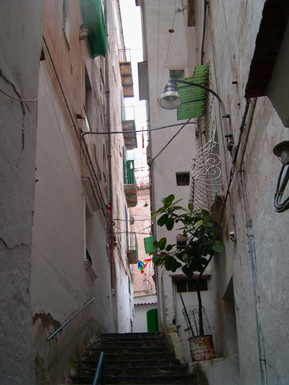
A passageway. |
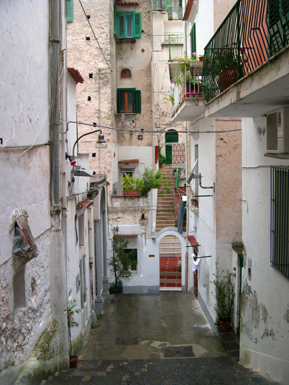
A passageway and houses. A satellite dish hangs on the white wall to the right - seems out of place here. |
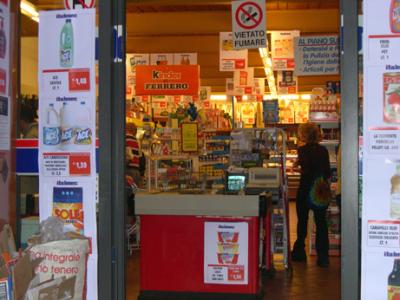
Grocery store where we bought snacks, soda and wine to take back to our hotel room. |
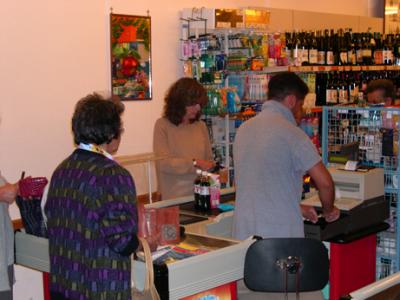
Judy shopping at the grocery store. |
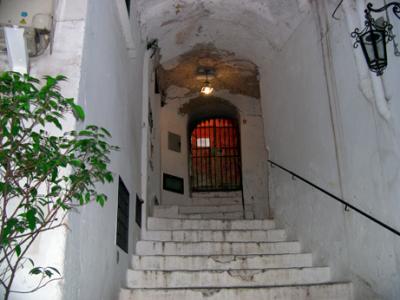
An entrance near the grocery store. |
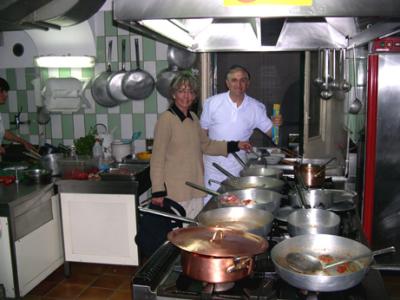
Judy "helping" the chef prepare a meal at Da Gemma Restaurant where we ate dinner. |
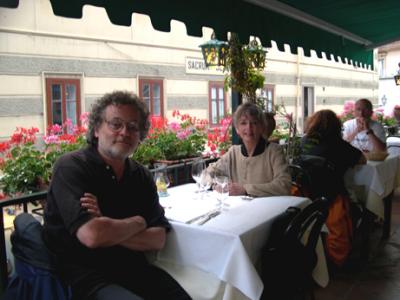
Dinner at Da Gemma Restaurant overlooking Via Lorenzo d'Amalfi, Amalfi's main street. |

Celebration of St. Rita seen from Da Gemma Restaurant. St. Rita (14th-15th c.) known as the, "Saint of the impossible." |
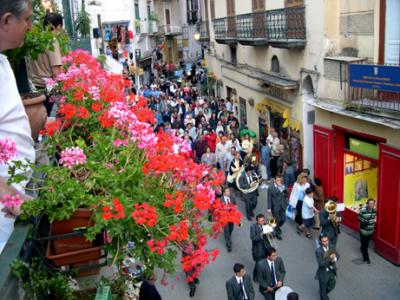
Procession (mainly women) for Saint Rita. Almost eveyone in town belongs to the church except for some Jehovah's Witnesses. |
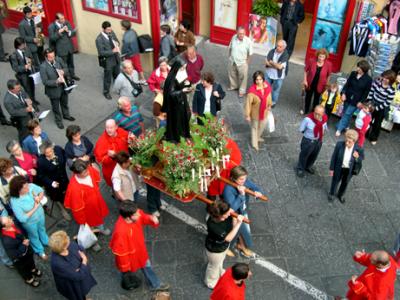
Feast of St. Rita (May 22): She is most meaningful to women and to those with heavy burdens to bear. |
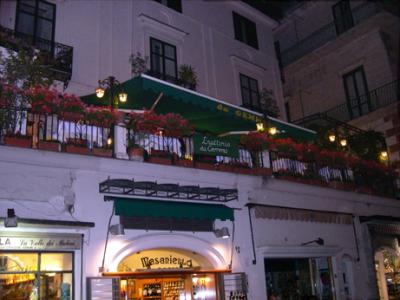
Da Gemma Restaurant: Photo taken after we had dinner there. |
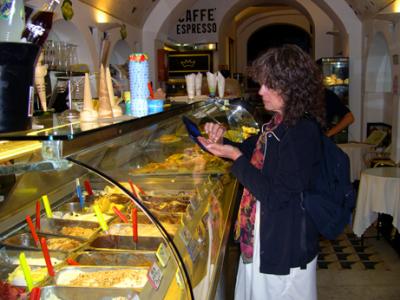
Judy finishing off the night with a gelato. |
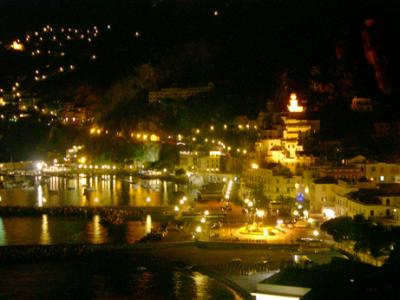
Amalfi at night from our patio. Amalfi was a major maritime power, rivaling Genoa and Venice, from the 9th to 11th centuries. |
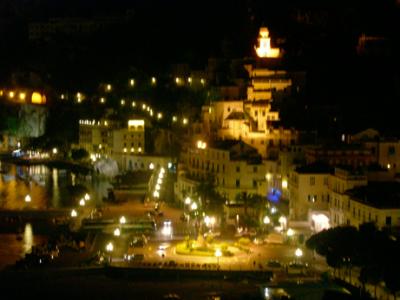
A closer view of Piazza Flavio Gioia at night from the patio of our hotel room (telephoto setting). |

Panorama & Judy's back: Click on thumbnail. Then click on "original" below this caption. Then use scroll bars (bottom & right). |











